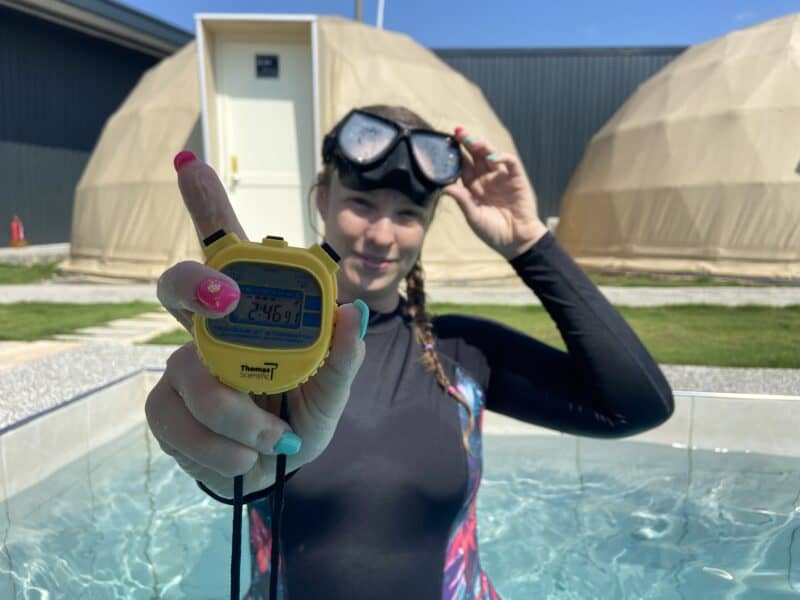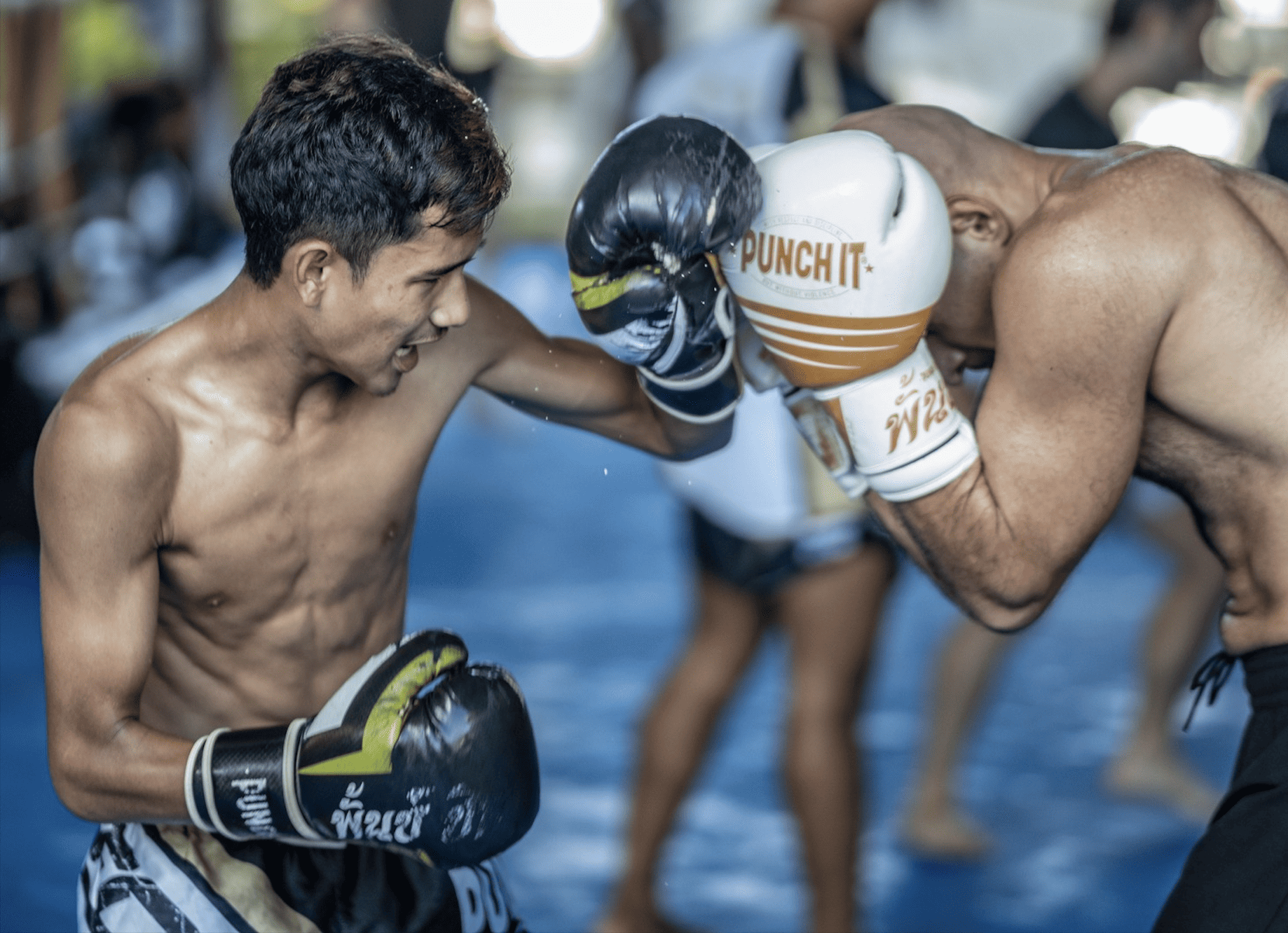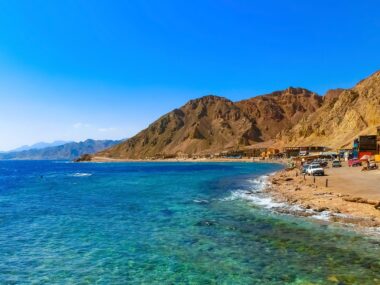Table of Contents
Freediving – the act of diving, but unlike scuba diving, we’re “free,” particularly when it comes to lugging around a 30-pound tank on our backs. And as much as I love scuba diving, there’s something about walking across the beach and hopping into the water with nothing but a mask, snorkel, and fins (and sometimes no fins!).
It sounds too easy, right?
Well, technically, no. While freediving can be done easily by holding our breath and dipping under the water to swim around a bit, going deeper for an extended period (while safely doing so) requires technical knowledge and practice.
And I guarantee learning to safely free dive in Taiwan or anywhere in the world will enrich your life – especially for those of us who love being in the water.
And that’s why I’m sharing my experience learning freediving in Taiwan – to spread the freedive love! I’ll cover the course learning experience and my silly (yet professional) instructor Ray, to the massive sea turtles you can meet on Xiaoliuqiu!
If you’re on the fence about taking a course, I aim to get you off the fence and at least 12 meters underwater.
So grab yourself water, coffee, or even a mixed drink and get ready to take notes as we dive (no pun intended) into freediving, the benefits, what it’s like taking a course, and why Xiaoliuqiu is the best place to take a freediving course (in English) in Taiwan!
Why I Said “Yes” to Learning How to Freedive in Taiwan
Growing up, I was an avid swimmer. Although I wasn’t swimming for sport, you could throw me into open water, and I’d be comfortable.
What started with fun pool days transformed into a love for being by and in the ocean.
My happy place became the Caribbean coast of Costa Rica, where I’d spend each day floating around on blue water, pretending to be a mermaid.
Once I moved to Taiwan, I even lived on a small island called Kinmen, and although I couldn’t swim in the water there, I loved being a five-minute walk from the ocean at all times.
As I fell more in love with living by the sea, I wanted to deepen my relationship with it, which meant going beyond just swimming or lying on the sand.
And that’s what I did in May of 2021, in Kenting, Taiwan, when I took a PADI open water diving course in English with Taiwan Dive (if you’re interested in scuba, I recommend learning with them 100%, shoutout to Eden!)
You can also view a YouTube video I created on the experience here.
With a whole new world opened up to me and my PADI Open Water Certificate, freediving began to linger in my head.
Scuba diving was fun, but it was expensive, required lots of equipment, and deep down, I loved to be free in the water. I wanted to swim, move quickly, and be playful.
But considering I had just invested $500 into my PADI course, I hesitated to invest another $500 into freediving, so I set the thought aside.
That’s when one day, I received an email from Freedive Nomad, another American living in Taiwan who taught freediving on a small island called Xiaoliuqiu.
He asked if I was interested in learning to free dive after he came across my YouTube channel and saw my scuba video. He invited me to learn to free dive in exchange for a YouTube video. The universe heard my plea, and I said yes!
And a month later, my friend Annie and I were on our way to Xiaoliuqiu, a tiny island off the South West Coast of Taiwan, to learn to free dive.
Freediving in Taiwan Destinations & Beach Info
Taiwan’s Beaches, What to Do + Where You Can Freedive in Taiwan
Despite being an island, if you want to enjoy the best beaches in Taiwan, you gotta make sure you go to the right place.
After living in Taiwan for two years, from personal experience, I can tell you some of the country’s best beach and ocean views include Kenting, the East Coast (especially Hualien and Taitung), Green Island, and Xiaoliuqiu.
Other destinations famous for their sea are Penghu and Lanyu — but I have yet to visit.
The cities of Kaohsiung and Tainan are pretty decent too, so you can enjoy a beach day there if you’re short on time and can’t reach any of the destinations listed above.
Here’s a short overview of the Taiwan beaches & some activities that can be enjoyed on each.
I have yet to do each activity on each beach, so if you are looking for a specific one in a certain location (i.e., canoeing on Taiwan’s East Coast), do a Google search, especially if you are seeking English-speaking guides and instructors.
Here are the best destinations, though, and their activities based on my knowledge:
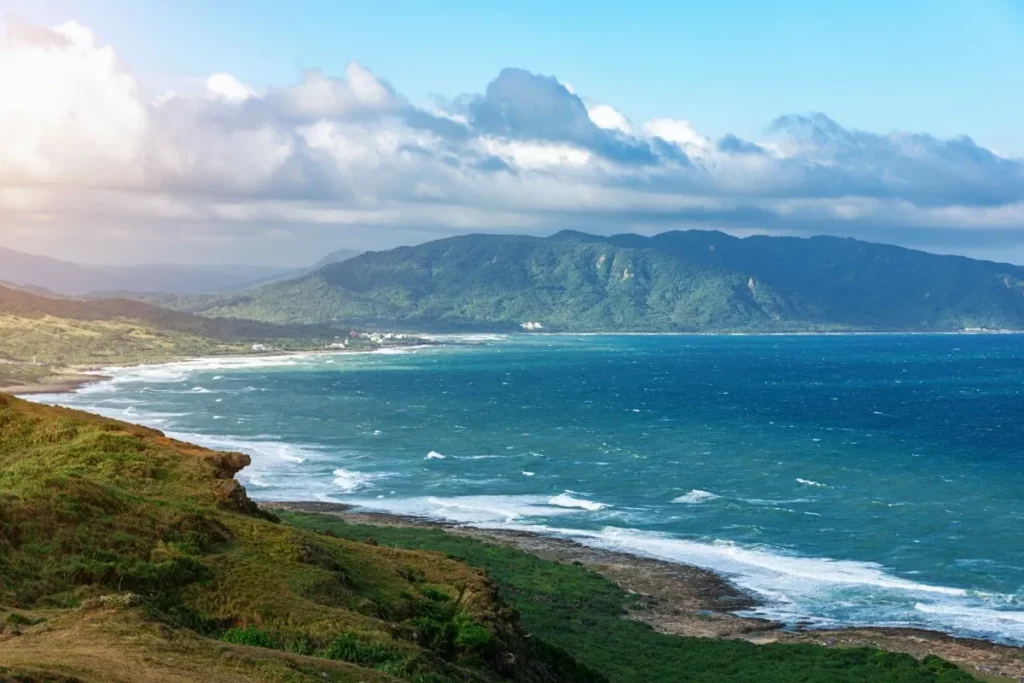
- Kenting – Great for swimming, scuba, and freediving
- East Coast Taiwan – is best for surfing, paddle boarding (I’d advise against swimming as the currents are strong)
- Penghu – Canoeing, snorkeling, scuba diving, paddle board
- Green Island & Lanyu – Scuba Diving & Freediving
- Xiaoliuqiu – Snorkeling, canoeing, paddle boarding, scuba, & freediving.
While you can swim at Xiaoliuqiu, the beach floors are primarily coral and rocks, so it’s ideal to know freediving to enjoy “swimming.”
- Northern Coast of Taiwan – Surfing
About Xiaoliuqiu
Now that I’ve covered Taiwan beaches and popular activities, let’s get more into Xiaoliuqiu.
I’ve been to Xiaoliuqiu at least five times to go freediving and enjoy all the other things to do in Xiaoliuqiu, such as canoeing, paddle boarding, and driving around an electric scooter (which foreigners can rent without a local license!)
The small yet hilly island is easy to explore in a day or two, with plenty of restaurants and natural sights to enjoy. The waters are so clear blue you’ll forgive the bottoms of the ocean floor for being so harsh.
The star of the island, though, is the sea turtles. Due to the shallow waters and abundance of coral and vegetation, sea turtles thrive here, chowing down, swimming about, and napping in between.
And aside from the freediving that keeps me coming back to Xiaoliuqiu, the blue waters and massive sea turtles are pretty great motivation.
How to get to Xiaoliuqiu:
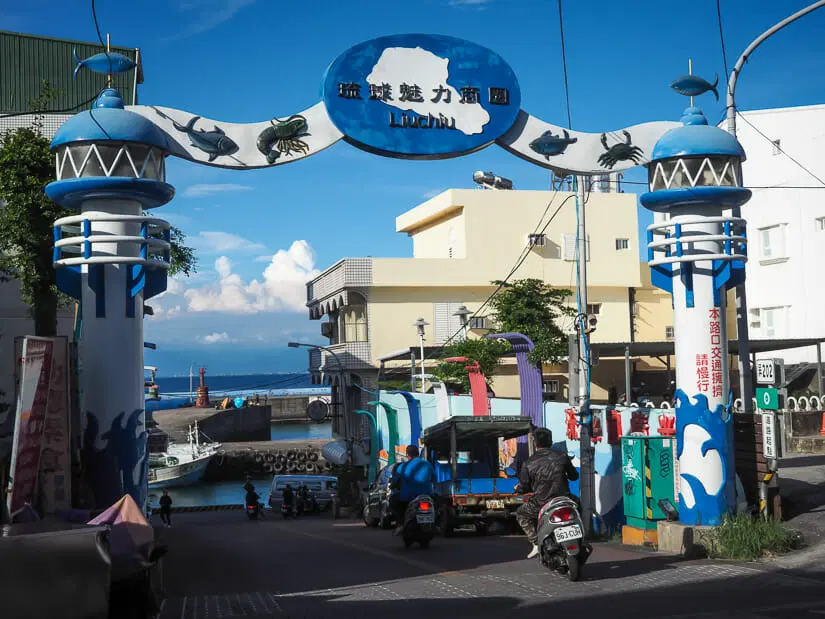
If you’re traveling through Taiwan, figuring out how to get to Xiaoliuqiu can seem tricky. Still, once you do it, it’s easy!
Here are two ways to get there – I’ll keep it simple, though, because there are plenty of other resources online.
If you decide to scuba or free dive with a company here, they can even assist you along the way to make sure you arrive without issues.
By car:
- Drive and park at either Yangpu or Doggang ferry terminals.
- Yangpu has free parking but only one company travels to the island and docks at an inconvenient location on Xiaoliuqiu. But you can coordinate with Ray or whoever you are learning with and they can help you get to the scooter rental location on the island.
- Donggang has multiple ferry operators that will bring you to the central hub of Xiaoliuqiu where you can hop off the ferry and rent your scooter right away (and easily walk to any central accommodation). At Donggang though, you will have to pay for parking.
By Public Transportation:
- From Zuoying High-Speed Rail Station in Kaohsiung, there’s a bus that will take you to Donggang Harbor. You can show up at the ticket booth and buy your ticket for the next bus, no need to buy online (although for holidays, you may want to check if it’s possible to buy ahead of time).
- When the bus drops you off in Donggang, you’ll see a row of ferry companies transporting passengers and goods to Xiaoliuqiu. You can really go with any of the companies.
- Once in Xiaoliuqiu, you can easily rent a scooter or walk to your accommodation if it’s central.
- Check the official Taiwan Shuttle Guide here for more detailed information.
Ultimately, I recommend taking public transport because taking the ferry from Donggang to the island is the most convenient and lands you in the central hub of everything.
Now that you’re convinced you need to go to Xialiuqiu in Taiwan AND know how to get there – let’s talk freediving in Taiwan.
All About Freediving
Every time I go freediving, one word describes how I feel before, during, and after the experience: whole.
At the end of the day, I’ll be tired, sweaty, and the sun had a field day on my skin — but as cheesy as it sounds, I can see my soul shining through it all.
Of course, if you come to learn freediving in Taiwan, you might take up some other words such as “calm,” “energized,” or “proud.”
This is because freediving is more than just dipping your head under the water and playing around momentarily. It’s a practice and hobby for the mind, body, and spirit – so let’s talk about what freediving is, what its benefits are, and who should learn.
What is freediving?
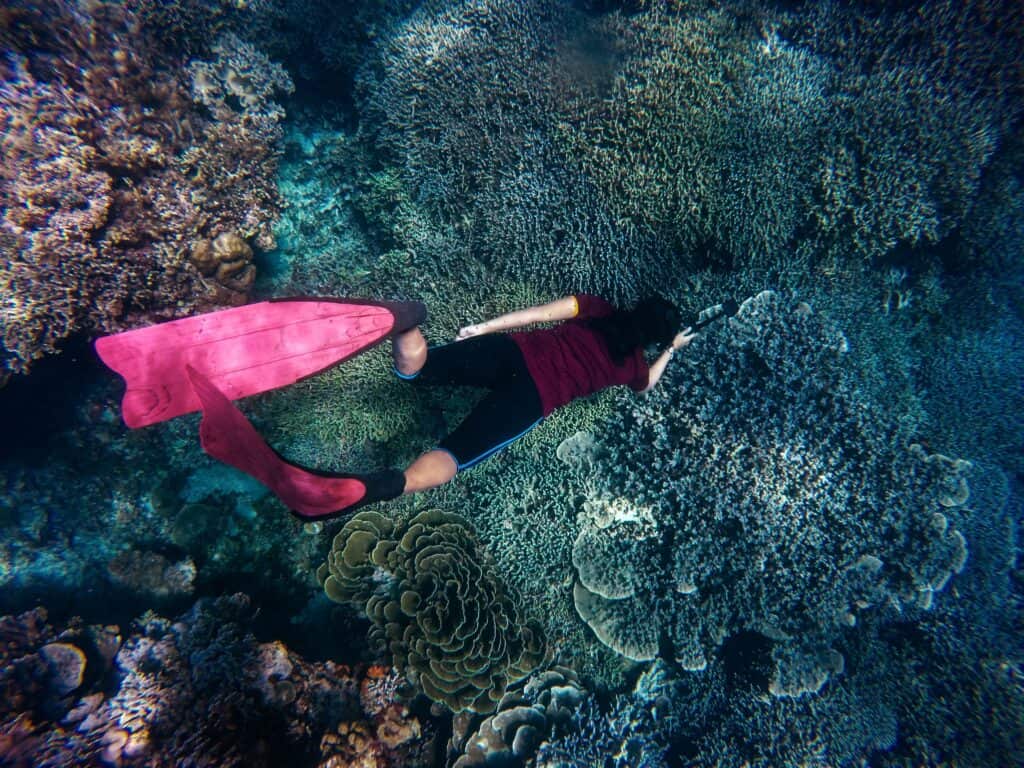
Put simply, freediving is diving underwater without an external air source, relying solely on holding one’s breath until returning to the surface.
It can be done for fun, for competition, for health, and as a profession (think teaching freediving, being a stunt double, or pearl diving!).
Aside from these reasons, freediving has historical roots that relate to culture and livelihood, such as Japan’s “ama” divers, who dove to catch seafood and pearls. Today, the tradition while much less common, still exists.
The Benefits of Freediving (The WHY)
Physical Health
Freediving holds a range of physical benefits, from being easy on the joints to increasing lung capacity.
It’s a full-body exercise where the results of its benefits can be seen externally and felt internally. It requires all the body muscles to move with control, building strength and endurance, and because it requires us to regulate our breathing, even our lungs and diaphragm benefit.
Mental Health
The physical benefits and challenges of freediving also bring mental health benefits. Of course, the exercise we get from freediving makes us feel good, but even more so does the relaxing mental benefits of freediving.
When freediving, we need to regulate our breath, visualize, and relax to remain safe and free dive easily. The practice of this while freediving creates a more relaxed mental space that can carry on into our lives on land.
Explore the Underwater World
If I can’t convince you to start freediving for the physical and mental benefits, let’s convince with the new world you can experience while freediving. As I’ve mentioned, Xiaoliuqiu is a sea turtle haven, and while I do love freediving, one of the most significant motivating factors for me every time I come to Xiaoliuqiu is being able to fun dive with the sea turtles.
Sorry Ray (my instructor’s name), I’m actually here for the turtles.
With freediving, there’s nothing like swimming alongside amazing underwater life, diving through underwater tunnels, and taking fantastic photos!
Who Should Learn Freediving?
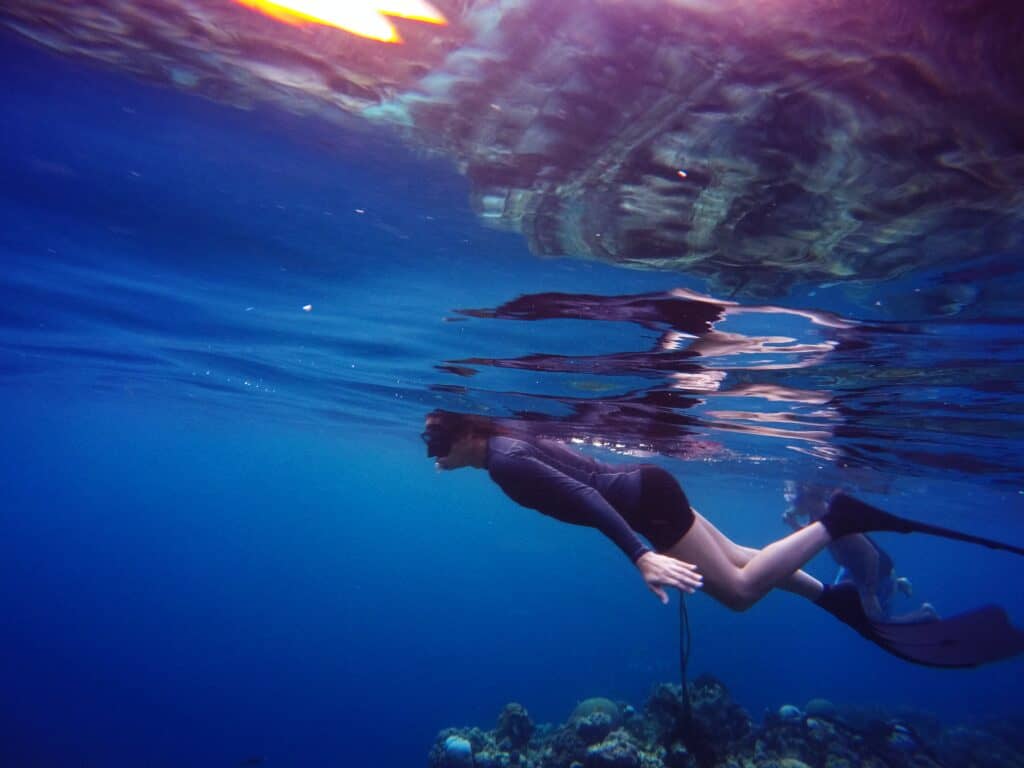
While anyone can learn freediving, it’s an investment. Luckily for me, I got my training as an exchange. Still, I knew before I got the offer, I would have eventually paid for a course.
Here are a few types of people I’d say should consider a freediving course & maybe you’re one of them!
- People who love spending time in the water and are interested in deepening their knowledge and experiences
- People who are already freediving without certification and want to deepen their knowledge, improve their technique, and ensure they’re being safe
- People who want to learn a new skill and challenge themselves
- For those who want to conquer any fear of the ocean or water (please consider the extent of this fear and discuss it with your instructor to make sure your course remains safe as possible for everyone) – freediving is excellent to push your limits of fears in the ocean but perhaps not to cure a deeper trauma
Still not sure if a free dive course is right for you?
There are also a few certification programs to consider, primarily including AIDA & Molchanovs.
Molchanovs Level 1 (or Wave 1, as they call it) is a three day in-depth program, while AIDA Wave 1 is only one day and a more simple introduction to freediving.
If you’re really not sure about taking the full Wave 1 Molchanovs Course, I’d recommend the AIDA Wave 1 course to get your feet wet and decide from there if you want to continue to level up.
Learning to Freedive in Xiaoliuqiu Taiwan With Freedive Nomad
The Certification
While Ray teaches both AIDA and Molchanovs curriculums, we’d be learning Molchanovs Wave. The course requires passing pool training, depth requirements, safety, rescue, and an online theory test. In total, we’d spend three days on Xiaoliuqiu while we could do the theory and online exam from home.
Knowing we’d had to dive down at least 12 meters (39.37 feet) to pass was the most intimidating at the time.
As a kid, I used to think I was cool swimming to the bottom of our 14-foot (4.27 meters) public pool, but 12 meters in one breath? Sounded impossible. After all, how am I not supposed to panic when attempting to dive so deep?
Right now I’m laughing because as of this writing, I‘ve passed Wave 1 and am now a Wave 2 student. My personal best depth is 27 meters; what?! Anyways, let’s go back in time to when I was just a baby freediver.
The Course Experience
Of all the things I learned in Taiwan, from scuba diving to Mandarin, learning to free dive in Taiwan is one of the most memorable and beloved experiences.
Here, I’ll cover the entire day-by-day experience in Xiaoliuqiu that Annie and I went through with our instructor Ray. I also vlogged the experience so you can check that out and visualize yourself freediving in Taiwan with us!
Watch the Freediving video here:
First Things First, Theory.
Before even getting into the water, we had to learn about freediving from the books – including the history, methods (such as visualization), and physiological occurrences in the body when we freedive. If you’ve learned scuba diving, it’s similar in that you need to know how everything works before you can hop in the water with a tank on.
So for this portion of the course, before we even arrived in Xiaoliuqiu, Ray, Annie, and I all hopped on a Zoom call to cover the book material, practice visualization, and our equalization techniques, all of which we’d apply in the actual water.
Diving in Xiaoliuqiu
After our theory lesson from home, our first trip to Xiaoliuqiu finally came. While we were there for the course, it was exciting to be traveling to a new part of Taiwan – like how did I never go to this island? I live only an hour away!
Annie, bless her and her car, drove us down to the harbor while we car Karaoke’d the whole way there.
We parked and got on the ferry, which took us to the more inconvenient side of the island — but Ray and his wife Sheila met us and offered us a ride on their scooters to take us to the main harbor where we would get set up with our own set of wheels.
After we got hooked up with our electric scooter rentals for the trip, Annie and I checked into our accommodation and took some time to explore the island.
My first impression of Xiaoliuqiu was that it was actually quite impressive. While small, the ocean was stunning – the most beautiful I had seen in Taiwan.
In addition, despite being such a tiny island, there were many food options, including burgers, Vietnamese food, and of course, Taiwanese food. To this day, I think Xiaoliuqiu has some of the best food in Taiwan despite being such a tiny location.
Day 1
The first day started with pool training which is not only important to check off the first few requirements, but also to get comfortable with the freediving basics, including how to properly kick with fins, equalize, and perform safety and rescue – after all, we’d use these skills in the open ocean the next day.
The first requirement was the static breath hold which means holding onto the pool ledge, ducking your head under, and holding your breath.
The requirement was 1 minute and 30 seconds, and I failed my first try as the urge to breathe kicked in, and I panicked a bit, lifting my head and gasping for air.
This is where the freediving theory comes in because the urge to breathe is actually CO2 building up the longer you hold your breath. Thus, the sensation is more of a feeling than an actual need for air. Of course, you will need air at some point, but the sensation can push you to quit earlier than you actually need to.

In addition, this is why visualization and relaxation are crucial in freediving because the more you relax, the calmer you are. Not only will the urge to breathe kick in later, but when you feel that urge to breathe, rather than panic, you can push through it to succeed – which is exactly how I accomplished the breath hold the second try.
The following requirements were even more critical to our skills because while easy to practice in a pool, we’d be taking them out into the ocean the next day.
First up was learning to use our fins properly to maximize our output with less energy. Not too hard, especially if you’re a swimmer already.
Next was take those fin skills and swim 30 meters across the pool on one breath. This would simulate what we’d experience in the ocean.
Honestly, it had me gasping for air at the end, and once again, I came back to the mindset of remaining calm and not moving too quickly to accomplish it.
Between the 30-meter swim and breath hold, one lesson I learned was to not get too excited knowing I could breathe again soon, because when I knew an exercise was about to end, I would get excited and become less relaxed, making the urge to breathe in those last few seconds almost torture.
A tip: don’t get too excited knowing you’ve almost finished a breath hold exercise; instead, recognize it’s nearly done, keep calm, and pace yourself until completion.
After finishing the breath hold exercises, we moved on to safety and practiced how to buddy and rescue correctly. Safetying was relatively easy as we had to practice swimming alongside Ray and then come up to the pool edge alongside him, simulating as if we were in the ocean coming up on the buoy.
Rescue, though – well, let’s say Annie and I are pros now. Sure, Annie may have knee’d Ray up his butt a few times. But considering we had to pull someone about twice our size to the surface — that’s precisely why we can rescue anyone at this point (well, given you’re not deeper than 16 meters).
And after all the tough stuff, our last exercise was re-enacting my childhood pool days. When I was a kid, I didn’t know what equalization was. Still, I was doing it as I’d hang my feet off the pool’s edge and hang upside down into the water, popping my ears along the way.
Well, Annie and I had to do the exact same thing for the final exercise and nailed it with flying colors.
Day 2
Suited up, weight belts on, and carrying two freediving buoys, we parked our scooters at one of Xiaoliuqiu’s most popular freedive beaches Dafu and swam 200 meters out to start our depth dives – dun dun dun!
Before getting into the skills we did; let me describe the whole setup.
The two buoys look like heavy-duty circular pool floaties, but with pockets in the middle for carrying drinks, weights, and other things. We attach them to an anchor which floats below the surface so as we practice, so we don’t magically float out into the sea.
One buoy is a place for a non-diving diver to hang out and rest, and the other, we hang a line (rope) down from it where the practicing diver will pull themselves down.
It’s like in gym class when you have the rope to climb up, except you’re climbing (or swimming) down the rope and into the ocean.
Now that we’ve got that image in your head (you can also see it in our video and photos above!) let’s move on.
Our first day was all about getting comfortable in the sea, getting used to diving for depth, and practicing techniques such as pulling ourselves down on the line, timing our equalization, and turning at the bottom without injuring ourselves. And, of course, check off a requirement or two to help us pass the course.
And let me tell you, diving for depth was scary as hell at first. Sure, can I dive up to 27 meters today…but going 12 meters below at the time was scary.
With each dive, one theme remained – visualize, relax, and breathe until you’re ready to dive.
After getting comfortable with equalizing, pulling myself onto the line, and turning to come back up at only around 6 meters deep, the one fear I had to conquer was going 12 meters below.
Doing the free immersion technique (where you use your arms to pull yourself down the line), the deeper I went, the more scared I got. The ocean got darker, I wanted to breathe, and I wasn’t equalizing well.
In fact, while I did make it to 12 meters after a few tries (checked off!), once I tried using the constant weight dive (where you don’t touch the line but instead fin all the way down), my equalization issues got worse, and I had to call it a day with some ear pain remaining.
Annie, on the other hand, despite being all like, “Oh, I’m not that great at swimming,” and so on, before we went to Xiaoliuqiu, nailed her 12 meters free immersion dive requirement on her first try. Show off.
Day 3
Our final day was upon us, and only a few requirements remained:
- 12-meter constant weight dive
- 6-10 meter buddying
- 6-10 meter rescue dive
Luckily for me, my ear problem and fear of depth were gone, so it was time to nail the constant weight dive.
Despite my confidence, it took 5 TRIES! And in fact, I made it to 12 meters each time, but always something was wrong: my finning, my turning, whatever. WHATEVER RAY, JUST LET ME PASS PLEASE.
Well, only on the 5th try did I come up, signaled my okay, and received a splash full of water on my face. When you get the splash, that’s the official sign you’ve done it!
As for Annie, again, she nailed it on her first try….sigh. Honestly, it was so badass to watch her be so good at freediving.
With our depth diving requirements out of the way, only two remained: buddying and rescue.
For buddying, just like in the pool, we’d meet Ray underwater about halfway through his dive and swim back up to meet him at the buoy to ensure he was okay.
It was overall easy – the only difficulty is instead of waiting to dive down wherever you want, you have to go down on a moment’s notice. It was a good challenge that would translate well into the final requirement: rescue.
Because unlike having to swim down at a moment’s notice while buddying, you not only have to meet them, but grab them (with the correct technique) and pull them to the surface.
You have to be ready to jump into action at a moment’s notice and it was actually very stressful for me.
But knowing it was our final requirement, knowing I could dive 12 meters, and knowing I wouldn’t black out (unless I panicked, perhaps), I pushed me through to get the rescue done. And I did. And so did Annie.
After our final ocean session, I had officially passed (as I had taken the online test earlier), and we sat anxiously waiting for Annie to take the online exam. She hit submit, and bam, she was hit with a pass!
& just like that, the world had two more Molchanovs certified divers.
How to Learn With Ray in Xiaoliuqiu
If you’re planning a trip to Taiwan and want to visit the best beaches in Taiwan, take a trip to Xialoiuqiu to meet the sea turtles, and learn a new, valuable skill – taking a freediving course in Taiwan in English with Ray is a no brainer.
Check out his website and Instagram for more information and to discuss how you can learn with him.
Ray’s goal is to make sure you have fun while training, so don’t be surprised if he or his assistant Sean come out of nowhere with being silly – don’t worry, they’ll save it for land only.
Deep Week in Taiwan 2023
Deep Week is an international event that brings freedivers from around the world together to explore the ocean depths on one breath – and Taiwan is the next host this November 18th to 25th, 2023.
And where will it be happening? On Xiaoliuqiu of course!
If you’re already a freediver or want to learn, this is your chance to experience some of the best freediving in the world with top global and Taiwanese record holders and champions. They’ll be running courses the whole week alongside lots of freediving activities.
They’ll be running courses and fun dives (with the turtles!) so if you want to learn to dive and do it among some of the best, book your tickets to Taiwan!
Read more about Deep Week and freediving in Taiwan here with National Geographic.
Freediving is Here to Stay With Me
As an avid swimmer and ocean lover, it was only natural I would keep exploring and pushing my limits with the underwater world, and freediving deepened my relationship with the underwater world.
Looking back, I needed to learn freediving, not only to indulge my love for being in the water but to prevent easily avoidable issues while doing so.
I’m able to enjoy the ocean, cenotes, and other beautiful waters around the world with confidence, almost feeling as if I’m a part of them, despite being a land being.
In addition, another beautiful benefit of learning to freedive is the high it gives you. No drugs involved, just levels of physical relaxation and mental calmness and satisfaction not even meditation can give me. After any freedive session, I feel, as I said before: whole.
Enjoying Swimming with the turtles and other unique underwater locations
Because I started learning to free dive in Taiwan in English on Xiaoliuqiu, swimming with sea turtles was the most notable and exciting benefit, aside from the physical and mental results.
While exploring Xiaoliuqiu, I discovered my favorite beach, where the sea turtles practically hung out in packs. They never cease to impress me, as some are almost as long as I am tall.
Sure, you can witness these beauties snorkeling on the surface. But there’s nothing like swimming alongside one or diving down a few meters and simply hanging out with one while they much on some vegetation.
Aside from Xiaoliuqiu, I’ve enjoyed freediving in other locations, such as Vietnam. I recall being invited on a scuba trip and when we arrived at the site, the dive was only a few meters deep, so I decided to free dive instead. I felt pretty cool, haha. Or that time, I randomly met a freediver at a cenote in Mexico, and he showed me a cool tunnel you could swim through.
Freediving safely
Being safe was one of the most important benefits of learning to free dive. Looking back, before freediving, I enjoyed trying to swim to depths. Still, I would do things like lifting my head too often, expending too much energy, or not correctly relaxing before diving. I see so many red flags I used to do.
With my course, I’m so grateful for the theory, knowledge, and experience I got because now I can dive deeper for fun and know how to do so to limit any danger I could be putting myself in.
The Cliché Conclusion
I think it’s safe to say if you’ve made it to the end of the article, you might be exhausted from reading it all, so let’s make this quick.
I’ve given you all the information I can from the best places to freedive in Taiwan, my full learning experience, who you can learn with in Taiwan, and why learning freediving is a fun (& useful) skill, especially for us ocean lovers!
It’s without a doubt, one of the best things I decided to ever learn and brings me so much joy, and I hope it does the same for you!
If you have any personal questions you can find me on Instagram (@kaylacosmos) or send me an email at cosmoskayla@gmail.com – I’m always happy to share information on Taiwan, Xiaoliuqiu and freediving with Freedive Nomad (Ray). Happy diving and ocean exploration!

